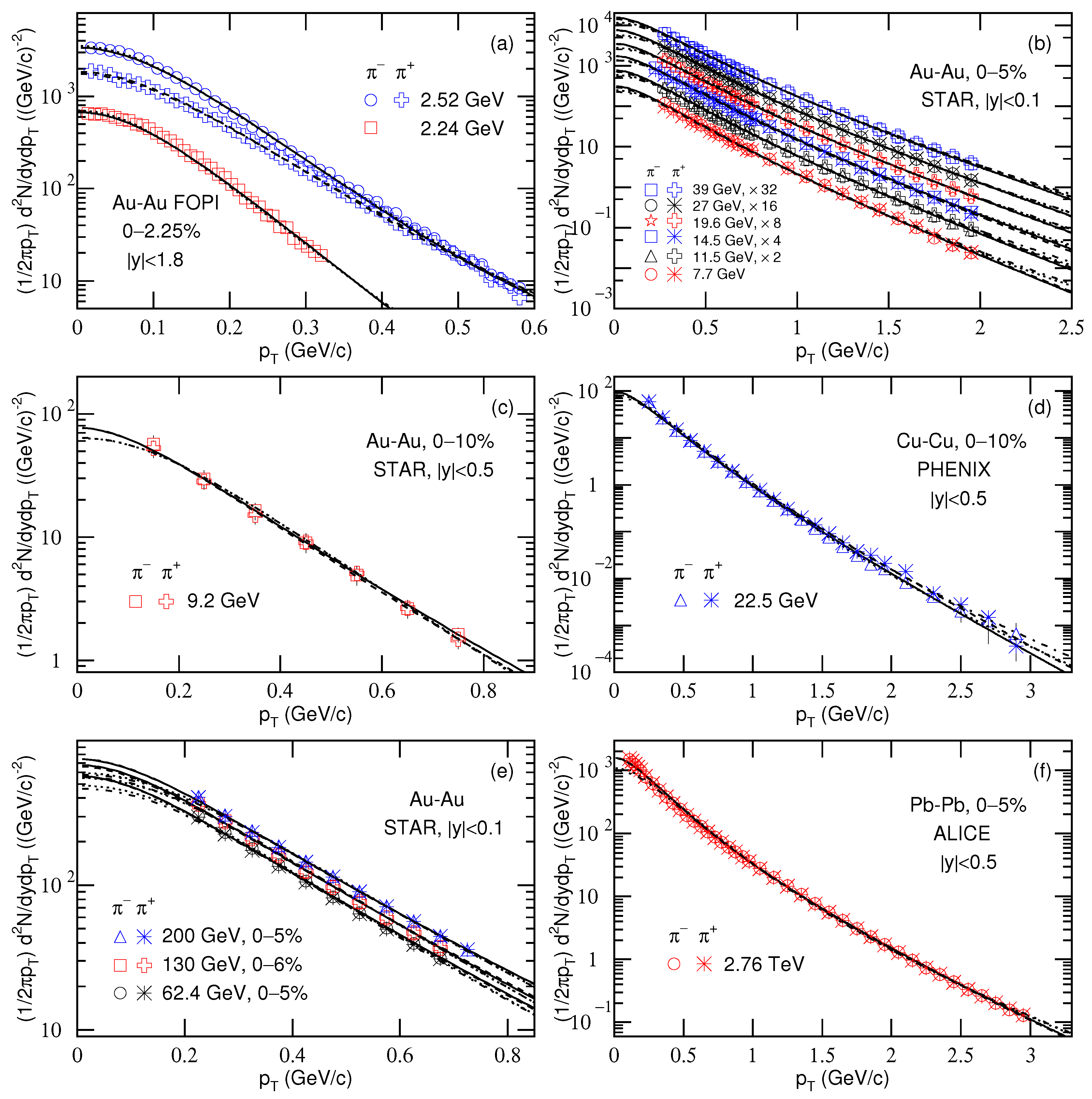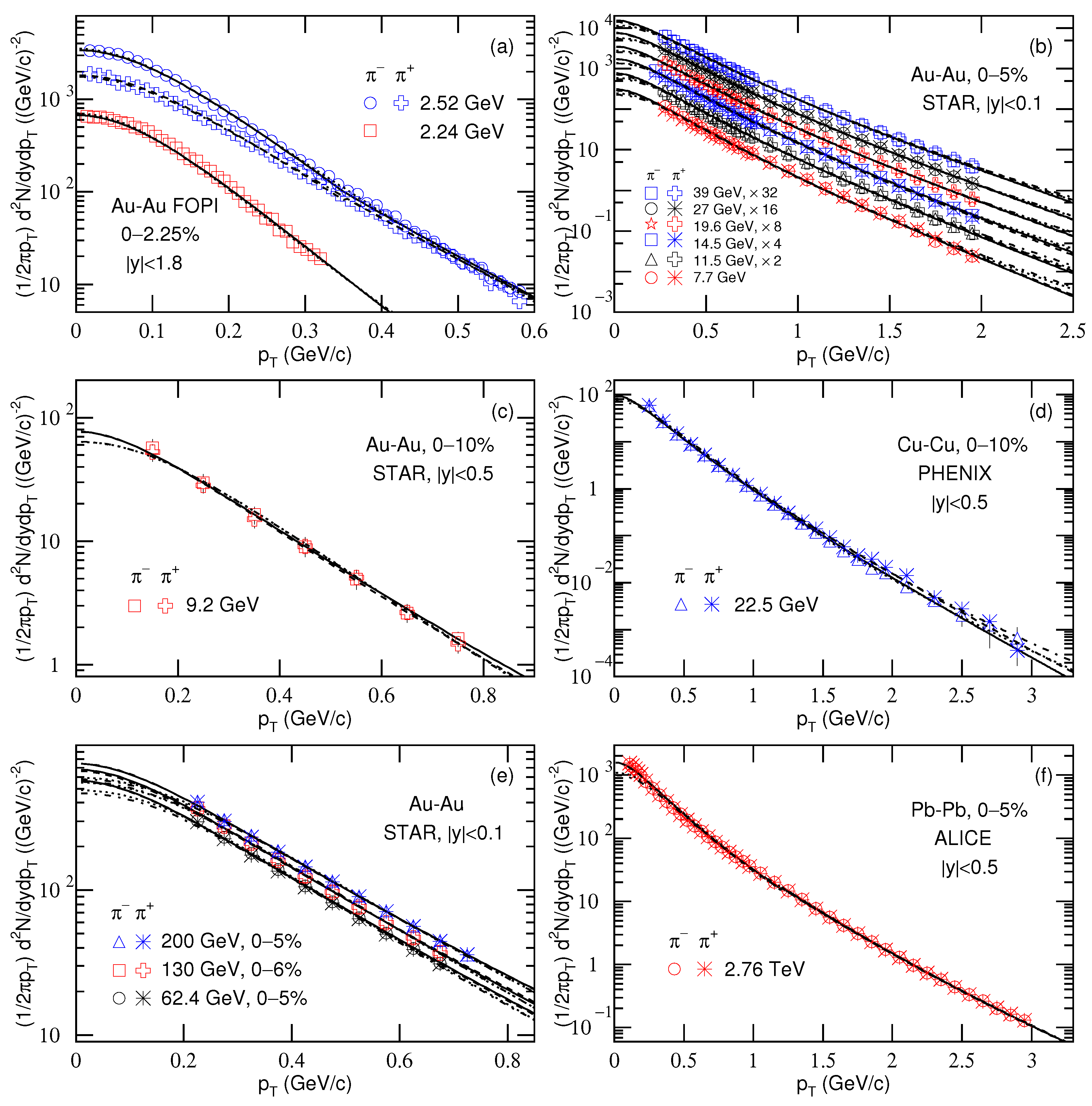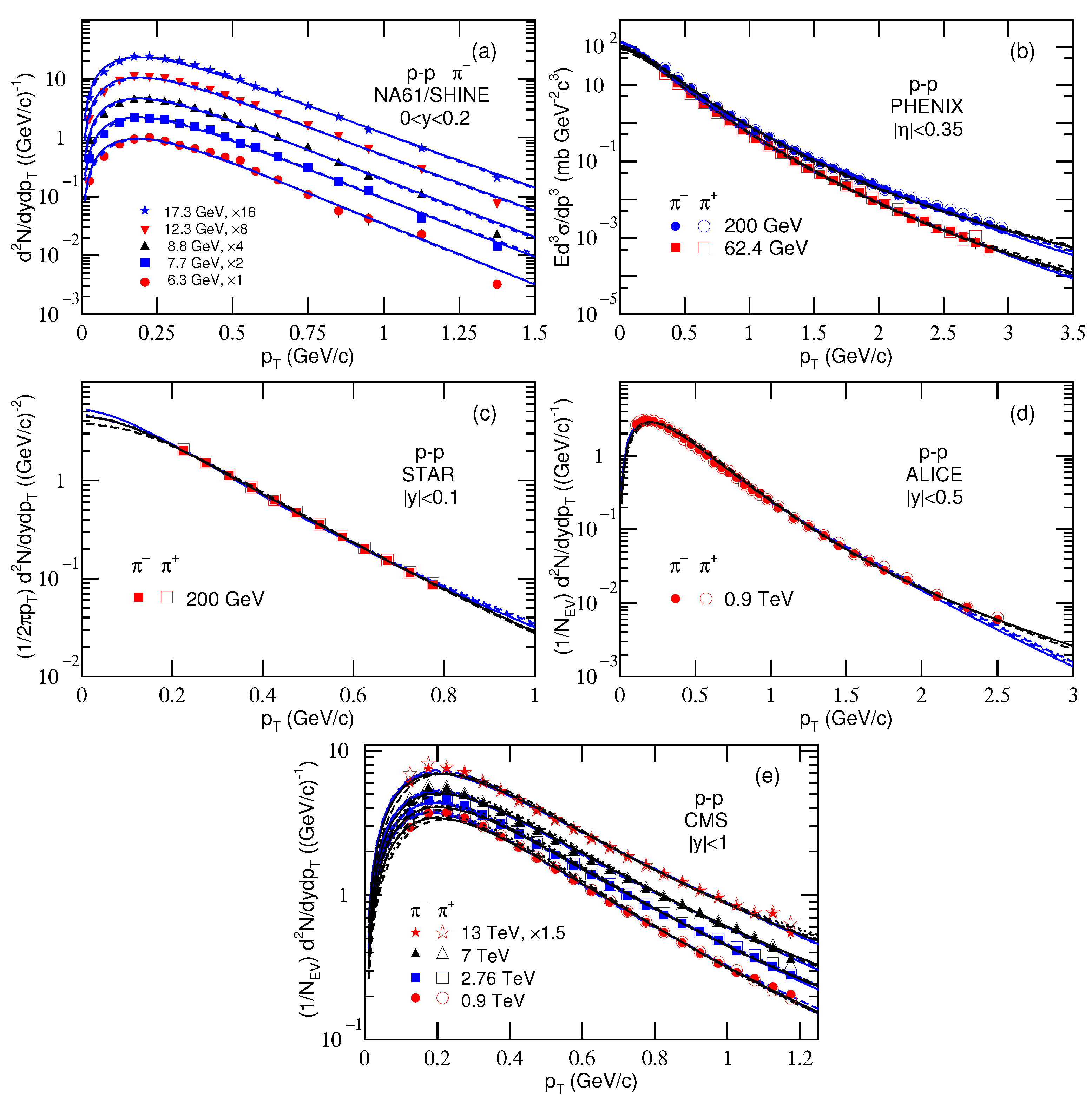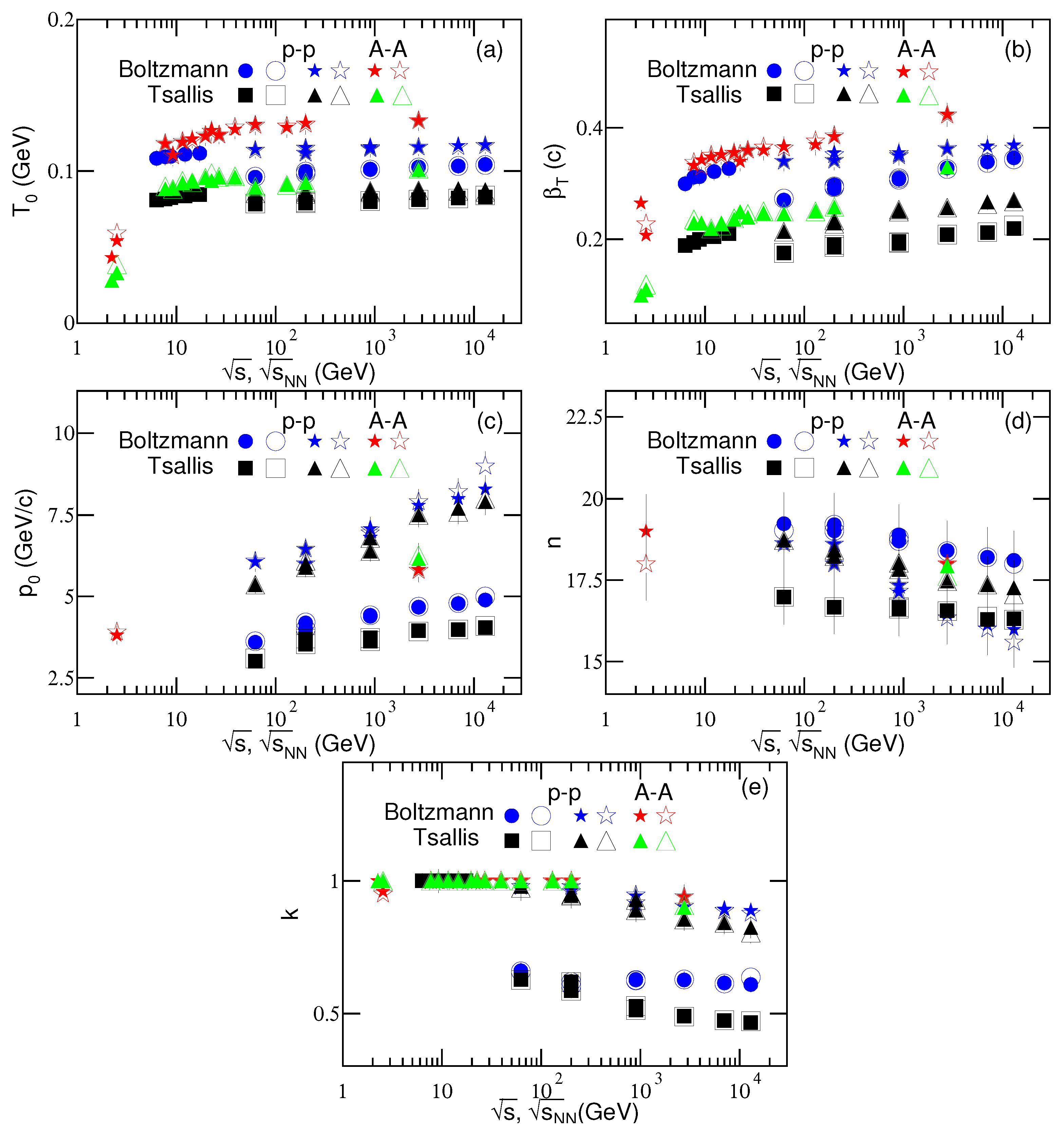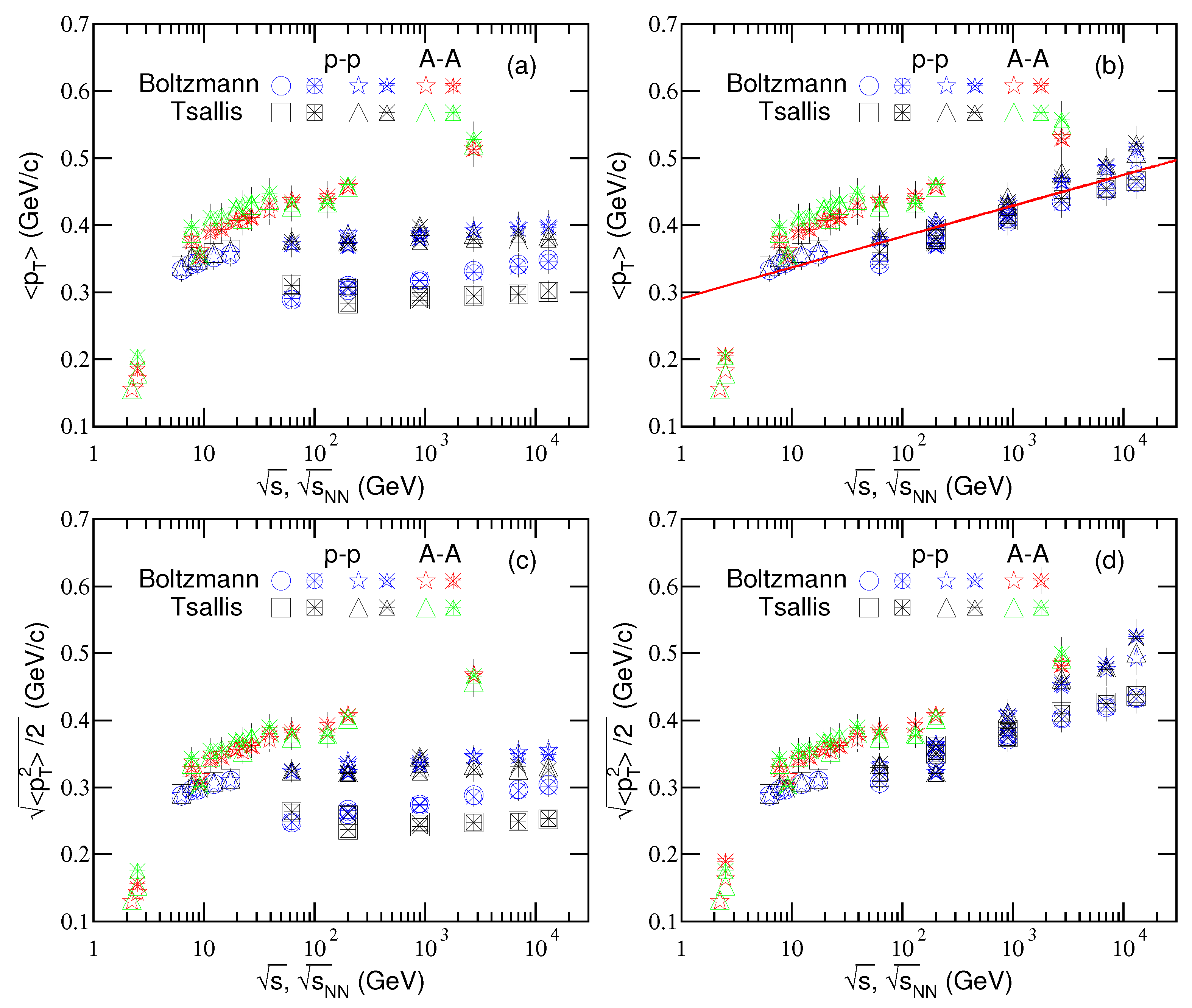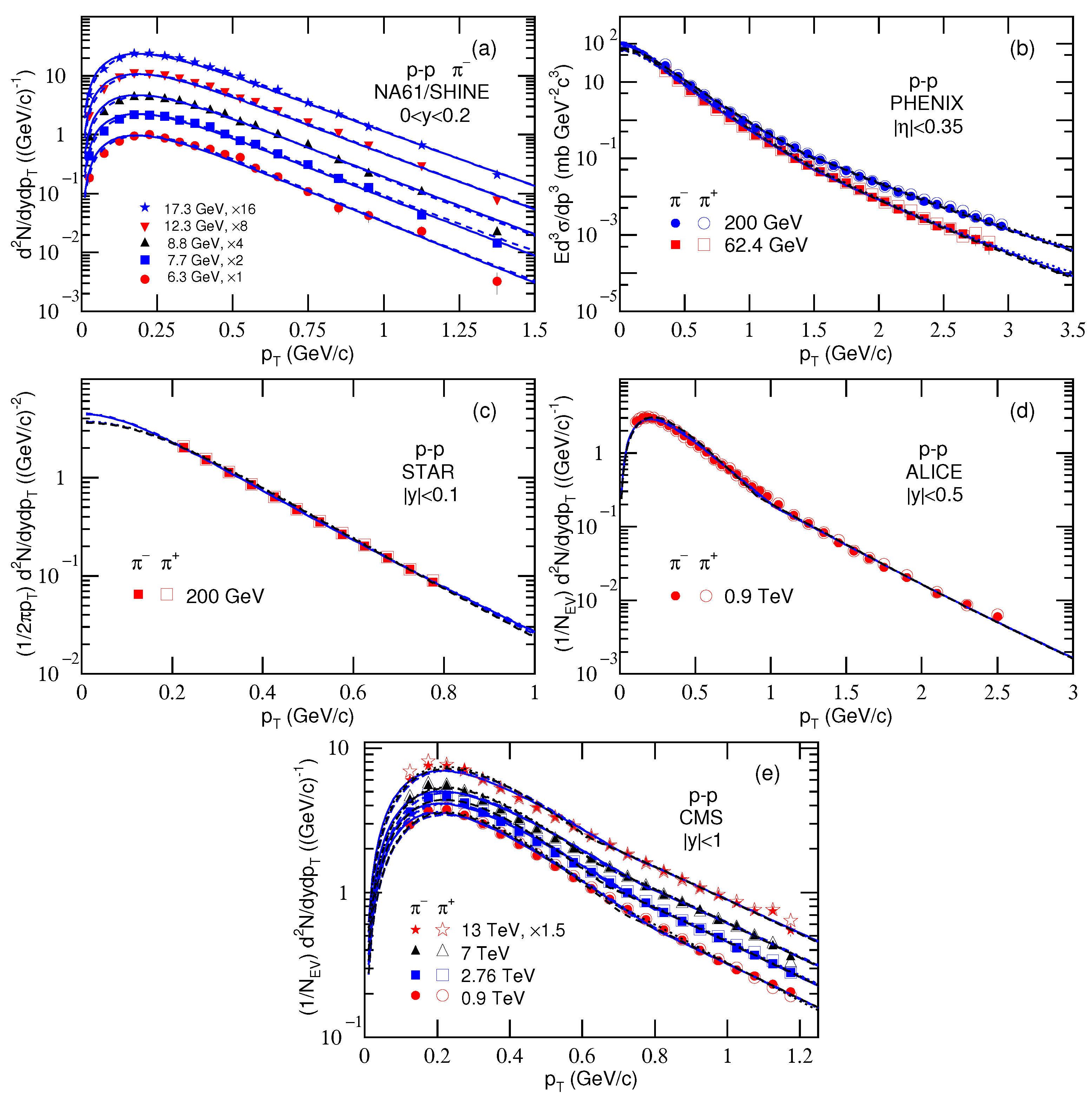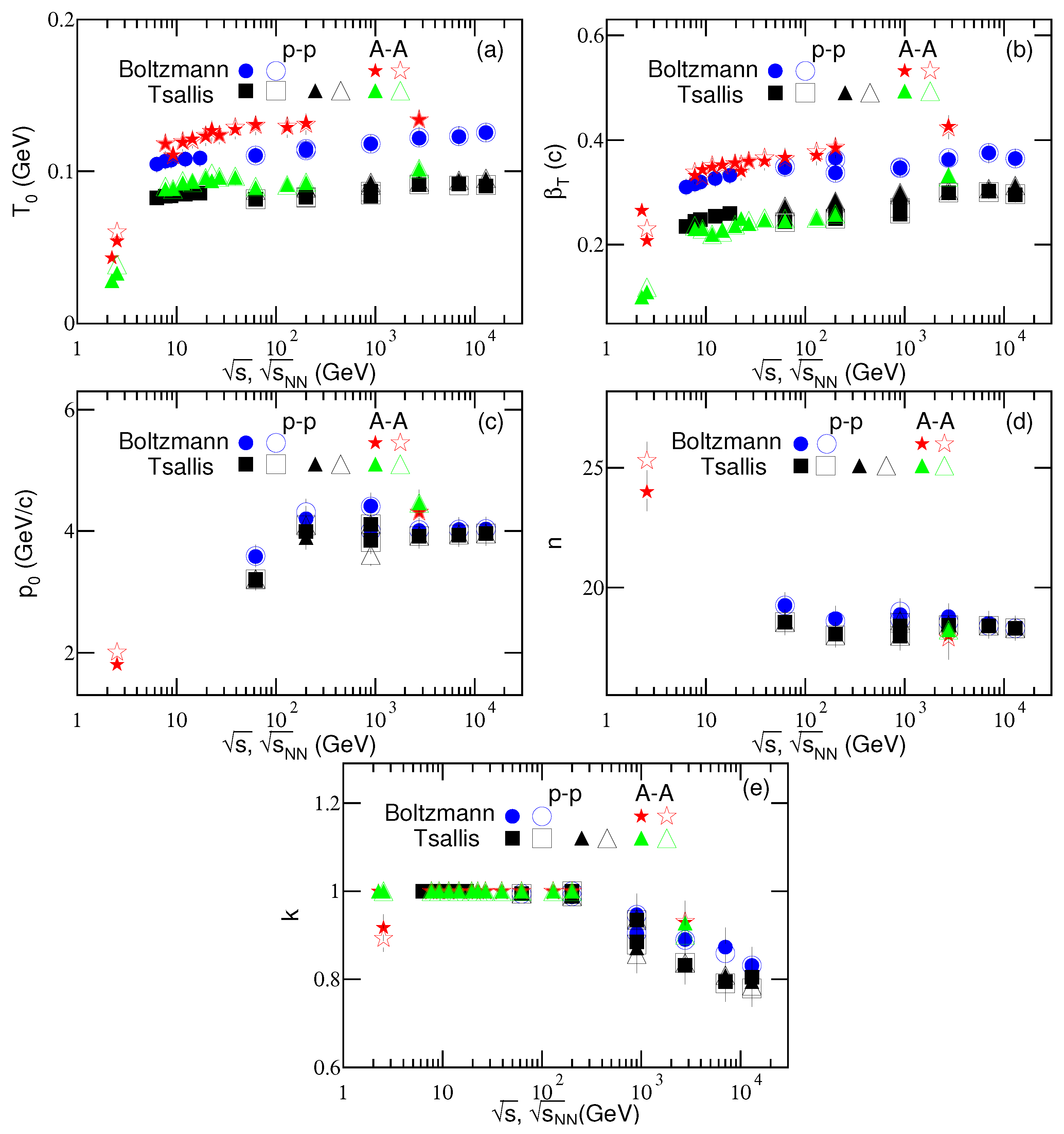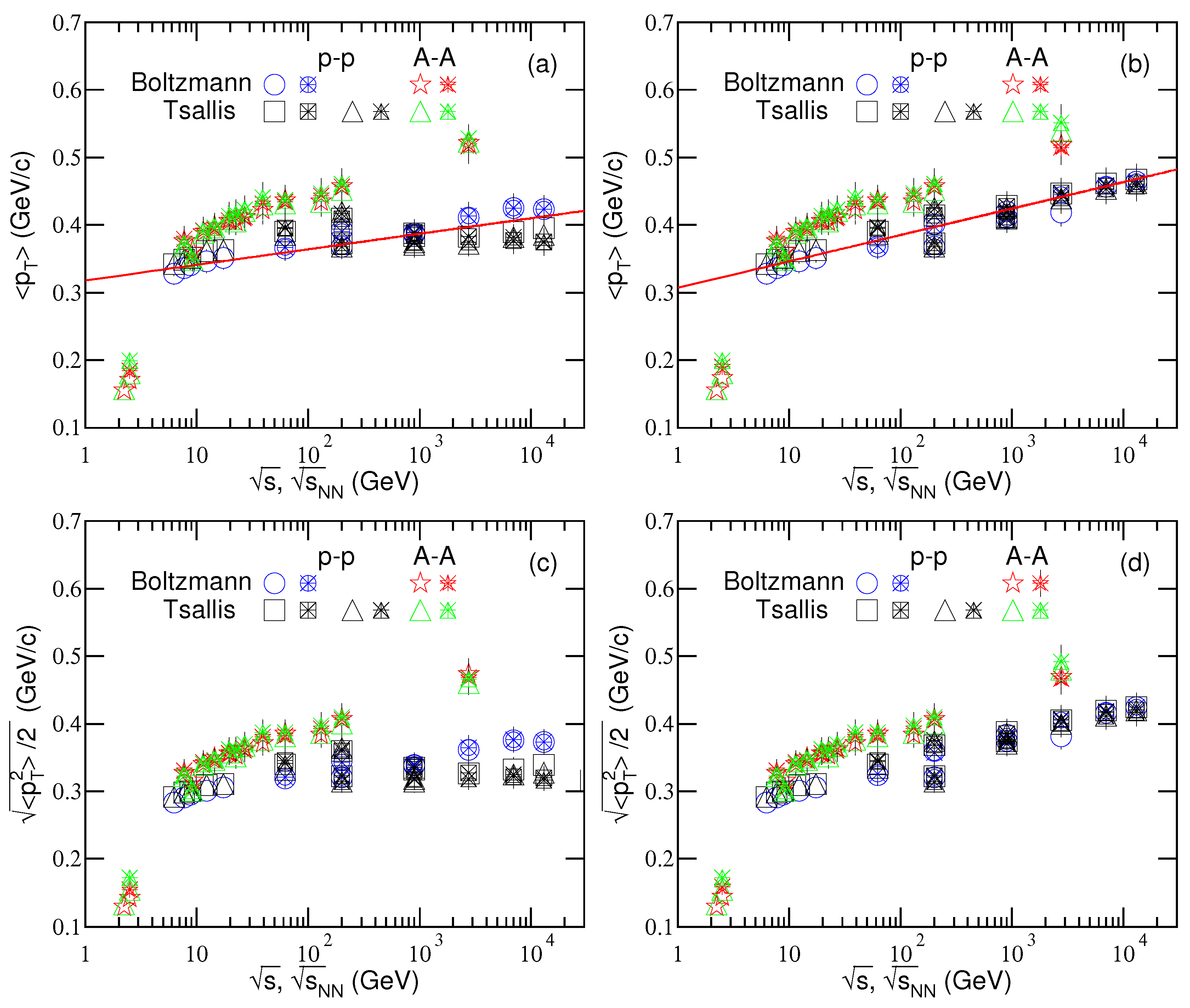3.1. Comparison with Data by Equation (7)
Figure 1 shows the transverse momentum spectra of
and
produced at mid-(pseudo)rapidity in
collisions at high center-of-mass energies, where different mid-(pseudo)rapidity (
y or
) intervals and energies (
) are marked in the panels. Different forms of the spectra are used due to different Collaborations, where
N,
E,
p,
, and
denote the particle number, energy, momentum, cross-section, and event number, respectively. The closed and open symbols presented in panels (a)–(e) represent the data of
and
measured by the NA61/SHINE [
24], PHENIX [
25], STAR [
6], ALICE [
26], and CMS [
27,
28] Collaborations, respectively, where in panel (a) only the spectra of
are available, and panel (c) is for NSD events and other panels are for INEL events. Although the
collisions are divided on the multiplicity classes in experiments on the LHC, we have used the minimum-bias INEL events [
26,
27,
28] which can be regarded as the combination of the events in different multiplicity classes with different yields. We regret not using the ATLAS Collaboration results [
44,
45,
46,
47,
48] given no data on the
spectra of
and
. These data show wider
spectra of charged particles to be used in our foreseen studies. In some cases, different amounts marked in the panels are used to scale the data for clarity. We have fitted the data by two sets of parameter values in Equation (
7) so that we can see the fluctuations of parameter values. The blue solid (dotted) curves are our results for
(
) spectra fitted by Equation (
7) through Equations (1) and (3), and the blue dashed (dot-dashed) curves are our results for
(
) spectra fitted by Equation (
7) through Equations (2) and (3), by the first set of parameter values, in which
k is taken to close to 0.5 as much as possible. The black curves are our results fitted by the second set of parameter values for comparison, in which
k is taken to close to 1 as much as possible. The values of free parameters (
,
,
q if available,
k,
, and
n), normalization constant (
),
, and number of degrees of freedom (ndof) corresponding to the curves in
Figure 1 are listed in
Table 1 and
Table 2, where the errors of fit parameters are obtained by the statistical simulation method [
49], no matter what
/ndof is. The parameter values presented in terms of value
/value
denote respectively the first and second sets of parameter values in Equation (
7) through Equations (1)–(3) in which
. One can see that Equation (
7) with two sets of parameter values describes the
spectra at mid-(pseudo)rapidity in
collisions over an energy range from a few GeV to above 10 TeV. The blast-wave fit with Boltzmann distribution and with Tsallis distribution presents similar results. The free parameters show some laws in the considered energy range. For a given parameter, its fluctuation at given energy is obvious in some cases. Because of the data being not available in very-low
range, Equation (
9) is not used in the fit.
It should be noted that, from the fit process we know that, the Tsallis expression, Equation (
2), having a polynomial behavior at large
could be a better description for the spectra at large values of
, where the Boltzmann expression, Equation (
1) does not work possibly at large
if we use the same parameters
and
. In some cases, for the spectra in a wide
range, a single Tsallis expression is suitable, and two- or three-component Boltzmann expression is needed. Our previous work [
50] studied both the Tsallis and Boltzmann distributions without flow effect and also confirms this issue. Indeed, the Tsallis description is better than the Boltzmann one, though the former has one more parameter
q. In fact, the introduction of the entropy index
q in the Tsallis description has the meaning of reality. As discussed in
Section 2,
q characterizes the degree of non-equilibrium. In addition, when
, the Tsallis description degenerates to the Boltzmann one.
To see clearly the excitation functions of free parameters,
Figure 2a–e show the dependences of
,
,
,
n, and
k on
, respectively. The blue and black closed and open symbols represent the parameter values corresponding to
and
respectively, which are listed in
Table 1 and
Table 2. The blue circles (black squares) represent the first set of parameter values obtained from Equation (
7) through Equations (1)–(3). The blue asterisks (black triangles) represent the second set of parameter values obtained from Equation (
7) through Equations (1)–(3). One can see that the difference between the results of
and
is not obvious. In the excitation functions of the first set of
and
obtained from the blast-wave fit with Boltzmann distribution, there are a hill at
GeV, a drop at dozens of GeV, and then an increase from dozens of GeV to above 10 TeV. In the excitation functions of the first set of
and
obtained from the blast-wave fit with Tsallis distribution, there is no the complex structure, but a very low hill. In the excitation functions of the second set of
and
, there is a slight increase from about 10 GeV to above 10 TeV. In Equation (
7) contained the blast-wave fit with both distributions, in the excitation functions of
and
n, there are a slight decrease and increase respectively in the case of the hard component being available. The excitation function of
k shows that the contribution (
) of hard component slightly increases from dozens of GeV to above 10 TeV, and it has no contribution at around 10 GeV. At given energies, the fluctuations in a given parameter result in different excitation functions due to different selections. As a comparison, the red asterisks (green triangles) in
Figure 2 represent the results from
collisions which are discussed in detail in the
Appendix A. One can see that the results from
collisions approach to those from
collisions with the second set of parameters, though only the soft component is used in most cases.
Indeed,
GeV is a special energy for
collisions as indicated by Cleymans [
51]. The present work shows that
GeV is also a special energy for
collisions. In particular, there is a hill in the excitation functions of
and
in
collisions due to a given selection of the parameters. At this energy (11 GeV more specifically [
51]), the final state has the highest net baryon density, a transition from a baryon-dominated to a meson-dominated final state takes place, and the ratios of strange particles to mesons show clear and pronounced maximums [
51]. These properties result in this special energy.
At 11 GeV, the chemical freeze-out temperature in
collisions is about 151 MeV [
51], and the present work shows that the kinetic freeze-out temperature in
collisions is about 105 MeV, extracted from the blast-wave fit with Boltzmann distribution. If we do not consider the difference between
and
collisions, though cold nuclear effect exists in
collisions, the chemical freeze-out happens obviously earlier than the kinetic one. According to an ideal fluid consideration, the time evolution of temperature follows
, where
(=300 MeV) and
(=1 fm) are the initial temperature and proper time respectively [
52,
53], and
and
denote the final temperature and time respectively, the chemical and kinetic freeze-outs happen at 7.8 and 23.3 fm respectively. It should be noted that in the calculation of
, the Lorentz factor is not considered. If we consider the mean Lorentz factor (
–6) of charged pions in the rest frame of emission source [
15,
16,
17,
18], the value of freeze-out time will be smaller.
Strictly, () obtained from the pion spectra in the present work is less than that averaged by weighting the yields of pions, kaons, protons, and other light particles. Fortunately, the fraction of the pion yield in high energy collisions are major (≈85%). The parameters and their tendencies obtained from the pion spectra are similar to those obtained from the spectra of all light particles. To study the excitation functions of and , it does not matter if we use the spectra of pions instead of all light particles.
It should be noted that the main parameters
and
are correlated in some way. Although the excitation functions of
(
) which are acceptable in the fit process are not sole, their tendencies are harmonious in most cases, in particular in the energy range from the RHIC to LHC. Combining with our previous work [
18], we could say that there is a slight (≈10%) increase in the excitation function of
and an obvious (≈35%) increase in the excitation function of
from the RHIC to LHC. At least, the excitation functions of
and
do not decrease from the RHIC to LHC.
However, the excitation function of
from low to high energies is not always incremental or invariant, though the excitation function of
has the trend of increase in general. For example, In [
4],
slowly decreases as
increases from 23 GeV to 1.8 TeV, and
slowly increases with
. In [
19,
20],
has no obvious change and
has a slight (≈10%) increase from the RHIC to LHC. In [
21],
has a slight (≈9%) increase and
has a large (≈65%) increase from the RHIC to LHC. In [
22,
23],
has a slight (≈5%) decrease from the RHIC to LHC and
increases by ≈20% from 39 to 200 GeV. It is convinced that
increases from the RHIC to LHC, though the situation of
is doubtful.
Although some works [
54,
55,
56,
57] reported a decrease of
and an increase of
from the RHIC to LHC, our re-scans on their plots show a different situation of
. For example, in [
54], our re-scans show that
has no obvious change and
has a slight (≈9%) increase from the top RHIC to LHC, though there is an obvious hill or there is an increase by ≈30% in
in 5–40 GeV comparting with that at the RHIC. Authors in [
55] shows similar results to [
54] with the almost invariant
from the top RHIC to LHC, an increase by ≈28% in
in 7–40 GeV comparing with that at the top RHIC, and an increase by ≈8% in
comparing with that at the top RHIC. Authors in [
56,
57] shows similar result to [
54,
55] on
, though the excitation function of
is not available.
In some cases, the correlation between
and
are not negative, though some works [
54,
55] show negative correlation over a wide energy range. For a give
spectrum, it seems that a larger
corresponds to a smaller
, which shows a negative correlation. However, this negative correlation is not sole case. In fact, a couple of suitable
and
can fit a given
spectrum. A series of
spectra at different energies possibly show a positive correlation between
and
, or independent of
on
, in a narrow energy range. Very recently, authors in [
58] shows approximately independent of
on
in
collisions at
TeV, and negative correlations in
p-Pb collisions at
TeV and in Pb-Pb collisions at
TeV, for different average charged-particle multiplicity densities, i.e., for different centrality classes. These results are partly in agreement with our results. It seems that the correlation between
and
is an open question at present, though some researchers think that there is a negative correlation between
and
. In our opinion, the type of correlation between
and
depends on three factors, that is the choices of fitted region in low and medium
range, fixed or changeable
, sensitivity of
on centrality. Indeed, more studies are needed in the near future.
To study further the behaviors of parameters,
Figure 3 shows the excitation functions of (a)(b) mean
(
) and (c)(d) ratio of root-mean-square
(
) to
, where the left panel [(a)(c)] corresponds to the results of the first component [Equation (
1) or (2)] and the right panel [(b)(d)] corresponds to the results of the two components [Equation (
7)]. The open symbols (open symbols with asterisks) represent the values corresponding to
(
) spectra. The blue circles (black squares) represent the values obtained indirectly from Equations (1) and (2) for the left panel or Equation (
7) through Equations (1)–(3) for the right panel, by the first set of parameter values. The results by the second set of parameter values are presented by the blue asterisks (black triangles). These values are indirectly obtained from the equations according to the parameters listed in
Table 1 and
Table 2 over a
range from 0 to 5 GeV/
c which is beyond the available range of the data. If the initial temperature of interacting system is approximately presented by
[
59,
60,
61], the lower panel shows the excitation function of initial temperature. Because of excluding different contribution fractions of the second component, the left panel [(a)(c)] shows some differences in the case of using two sets of parameter values. It should be noted that the root-mean square momentum component of particles in the rest frame of isotropic emission source is regarded as the initial temperature, or at the least it is a reflection of the initial temperature. The relations in the left panel are complex and multiple due to different sets of parameter values. The line in
Figure 3b is fitted to various symbols by linear function
with
/ndof = 54/82. From the line one can see that the behavior of
. In particular, with the increase of
and including the contribution of second component,
increases approximately linearly. As a comparison, the red asterisks (green triangles) in
Figure 3 represent the results for
collisions, which are indirectly obtained according to the parameter values listed in
Table A1 and
Table A2. One can see that the results for
collisions are greater than those for
collisions at around 10 GeV and above.
The quantities
and
are very important to understand the excitation degree of interacting system. As for the right panel in
Figure 3 which is for the two-component, the incremental trend for
and
with the increase of
(
) is a natural result due to more energy deposition at higher energy. Although
and
are obtained from the parameter values listed in
Table 1 and
Table 2 (A1 and A2), they are independent of fits or models. More investigations on the excitation functions of
and
are needed due to their importance.
3.2. Comparison with Data by Equation (8)
To discuss further, for comparisons with the results from Equation (
7), we reanalyze the spectra by Equation (
8) and study the trends of new parameters.
Figure 4 is the same as
Figure 1, but showing the results fitted by Equation (
8) through Equations (1) and (3) and through Equations (2) and (3) respectively. For Equation (
8) through Equations (1) and (3), only one set of parameter values are used due to the fact that there is no correlation in the extraction of parameters in the two-component fit. For Equation (
8) through Equations (2) and (3), two sets of parameter values are used to see the insensitivity of main parameters. The first set of parameter values are obtained by the method of least squares. The second set of parameter values are obtained by increasing or decreasing main parameters (
,
,
q, and
k) by a few percent, and limits the increase of
by a few percent. The values of related parameters are listed in
Table 3 and
Table 4 which are the same as
Table 1 and
Table 2 respectively, and with only one set of parameter values in
Table 3. The related parameters are shown in
Figure 5 and the leading-out parameters are shown in
Figure 6, which are the same as
Figure 2 and
Figure 3 respectively, and with only one set of parameter values for Equation (
8) through Equations (1) and (3). In particular,
k in
Figure 5 is obtained by
due to
is normalized to 1, as discussed following Equation (
8). The lines in
Figure 6a,b are fitted by linear functions
and
with
/ndof = 55/61 and 28/61 respectively, though the linear relationships between the parameters and
may be not the best fitting functions. Similar to
Figure 2 and
Figure 3, the results for
collisions from Equation (
8) are also presented in
Figure 5 and
Figure 6 for comparisons. One can see the similarity in both
and
collisions in the considered energy range.
From
Figure 4 one can see that Equation (
8) fits similarly good the data as Equation (
7). Because of the data being not available in very-low
range, Equation (
10) is not used in the fit.
and
in
Figure 5 increase slightly from a few GeV to above 10 TeV with some fluctuations in some cases, which is partly similar to those in
Figure 2. Other parameters in
Figure 5 show somehow similar trends to
Figure 2 with some differences. The left panels in
Figure 3 and
Figure 6 are different due to the first component being in different superpositions. The right panels in
Figure 3 and
Figure 6 are very similar to each other due to the same data sets being fitted. We would like to point out that
Figure 1 and
Figure 4 present various cases which are displayed together and result in
Figure 2 and
Figure 3 as well as
Figure 5 and
Figure 6 depicting much more data in which some energy points are taken from
Figure A1 and
Figure A2 in the
Appendix A.
Before continuing this work, we would like to point out the justification and correctness for the comparisons of
and central
collisions in
Figure 2,
Figure 3,
Figure 5 and
Figure 6. No matter peripheral or central
collisions, a set of nucleon-nucleon collisions in participant region are similar to the minimum-bias
collisions. Peripheral
collisions are similar to central collisions with smaller projectile and target nuclei, while central
collisions are just central collisions with large nuclei. Because of collision energies considered in this work are high, the nucleon-nucleon correlation, cluster structure, medium effect, and other nuclear effects in participant region can be neglected. Meanwhile, the cold nuclear or spectator effect in non-central
collisions can be neglected, too. In our opinion, we may compare the minimum-bias
collisions with the
collisions in any centrality class.
Combining with our recent work [
62], it is shown the similarity in
and
collisions, though
collisions appear larger
,
,
, and
in most cases. Moreover, it is well seen that Tsallis does not distinguish well between the data in
and
collisions [
63,
64,
65]. Indeed, at high energy, both
and
collisions produce many particles and obey statistical law. In addition,
collisions are the basic sub-process in
collisions. It is natural that
and
collisions show similar law. However, concerning around 10–20 GeV change, this is expected as soon as QCD effects/calculations may not be directly applicable below this point, plus seem to be smoothed away by other processes in
collisions. This is well visible as a clear difference as shown in [
63,
64,
65], where the data in
collisions goes well with the data in electron-positron collisions, while the data in
collisions are different.
The differences between Equations (7) and (8) are obviously, though the similar components are used in them. In our recent works [
18,
66], Equations (7) and (8) are used respectively. Although there is correlation in the extraction of parameters, a smooth curve can be easily obtained by Equation (
7). Although it is not easy to obtain a smooth curve at the point of junction, there is no or less correlation in the extraction of parameters by Equation (
8). In consideration of obtaining a set of parameters with least correlation, we are inclined to use Equation (
8) to extract the related parameters. This inclining results in Equation (
8) to separate determinedly the contributions of soft and hard processes.
It should be noted that the system of
collisions at low energy is probably not in thermal equilibrium or local thermal equilibriums due to low multiplicity, which is not the case of the present work. In fact, the present work treats
collisions at high energies in which the multiplicities in most cases are not too low. In addition, related review work [
67] shows that small system also appears similar collective behavior to
collisions. This renders that the idea of local thermal equilibrium is suitable to high energy
collisions for which the blast-wave fit can be used, though QGP is not expected to form in minimum-bias events.
Although we have used the blast-wave fit in the superposition function with two components in which the second component is an inverse power-law, the blast-wave part is not necessary for fitting process itself. In fact, the superposition of (two-)Boltzmann (or Tsallis) distribution and inverse power-law can fit the data in most cases [
30,
31,
65]. In particular, in our very recent work [
68], we used the Tsallis–Pareto-type function [
28,
69,
70] to fit
spectra in a wide range, in which there is no boosted part. The merits of the boosted part are that some additional quantities such as
and
can be obtained and physics picture is more abundant.
To avoid the dependences of and on fits or models, one can use to describe synchronously and . Generally, is independent of fits or models, though it can be calculated from fits or models. Averagely, the contribution of one participant in each binary collisions is which is resulted from both the thermal motion and flow effect. Let denote the contribution fraction of thermal motion. The contribution fraction of flow effect is naturally . Thus, we define and . As a free parameter, depends on collision energy, which is needed to study further.
3.3. More Discussions
Before summary and conclusions, we would like to underline the preponderance of the present work. Comparing with PYTHIA or other perturbative QCD simulation tools [
71,
72,
73,
74], the present work is simpler and more applicative in obtaining the excitation functions of
and
, though the usual fitting method is used. In a recent work [
75], it was pointed out that the PYTHIA Monte Carlo [
71,
72] disagrees with some data, and the two-component (soft+hard) model describes the data accurately and comprehensively, though the two-component model used in [
75] is different from the fit used in the present work. In addition, the present work is a data-driven reanalysis based on some physics considerations, but not a simple fit to the data. From the data-driven reanalysis, the excitation functions of some quantities have been obtained.
From the excitation functions, one can see some complex structures which are useful to study the properties of particle production and system evolution at different energies. In particular, in the energy range around 10 GeV, the excitation functions have transition which implies the phase of interaction matter had changed. In addition, by using the two-component fit, the present work also presents a new method to extract the contribution fraction of hard component. One can see that this contribution fraction is 0 in the energy range around 10 GeV. This implies that the interactions in the energy range around 10 GeV have only soft component, and that above 10 GeV have both soft and hard components. The interaction mechanisms in the two energy ranges are different.
We would like to emphasize that the aim of the present work is to look for possible signatures of a transition from baryon-dominated to meson-dominated hadron production mechanism by fitting pion
spectra at mid-(pseudo)rapidity in
collisions which also show collective phenomenon [
67]. The main conclusion regards a possible indication of such an effect at about 10–20 GeV visible in a drop of the temperature extracted using a blast-wave model with Boltzmann distribution to model the soft excitation mode. Such a conclusion seems not straightforward since the results are strongly biased by different
used to fit data at different energies. In fact, the results are less affected by
due to the fact that the parameters are mainly determined by the spectra in low and intermediate
regions. Larger
does not change the trend of inverse power-law, which does not affect obviously the parameters. Although
has no obvious influence on the parameters, we have used
Gev/
c in our calculation.
It should be noted that the blast-wave analysis is known to be sensitive to the selected range in the case of using a not too wide and local one such as 1–2 GeV/c. To avoid this dependence, we have used a wide enough range from 0 to a large value, but not a narrow and local one. In addition, looking at the fit results when using a Tsallis function to describe soft excitation processes such a drop in the k-parameter is no longer visible which seems to mean that the fit is less sensitive to the hard component and also less sensitive to . Using the Tsallis function assumption also the drop in the temperature is no longer visible which means that the effect on the temperature seen with the Boltzmann assumption seems to be model dependent. In fact, the parameters discussed in the present work are indeed model dependent. We hope to extract model independent parameters in the near future. Our definition and are a possible choice for the model independent parameters.
On the other hand, although comparing Boltzmann with Tsallis is an interesting physical problem, which could not be understood without another comparison with the generic super-statistics, as the one implemented in particle productions [
76,
77,
78,
79]. The latter—in contrary to Boltzmann and Tsallis—lets the system alone judge about its statistical nature, whether extensive or non-extensive (equilibrium or non-equilibrium). As pointed out in [
76,
77,
78,
79], the particle production at BES energies is likely a non-extensive process but not necessarily Boltzmann or Tsallis type. Indeed, further study on particle production in high energy collisions is needed in the future.
In particular, larger
means higher excitation degree and shorter lifetime of the fireball formed in high energy collisions. At the LHC energy, the fireball should have higher excitation degree comparing with that at the top RHIC energy, though longer lifetime is possible at the LHC energy [
55,
80]. As a result of competition between excitation degree and lifetime,
shows the trend of increase with energy in the present work. Meanwhile, our result on larger
means quicker expansion at the LHC energy. These trends are harmonious with those of
and
as well as other method such as the alternative method [
16,
18,
66] by which
and
are also obtained.
